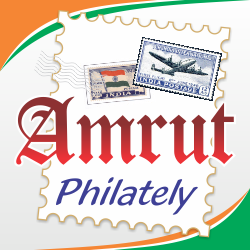Philately
WHAT IS PHILATELY
A Frenchman, Georges Herpin, coined the word Philately, meaning the study of postage stamps, stamped envelopes, postmarks, postcards and other material relating to postal delivery. It has been derived from Greek "philos" meaning "love" and "ateleia" meaning "that which is tax-free"; the post came free of charge to the recipient rendering it untaxed.
The hobby of collecting stamps perhaps started with the lady who advertised in The Times of London in 1841 - "a young lady, being desirous of covering her dressing-room with cancelled postage stamps."
Stamp collecting is all about collecting stamps and arranging them in albums. Philately, is real serious stamp study. A philatelist collects stamps, arranges them and knows a whole lot about its history, manufacture and about the information portrayed on it.
History of Philately in India
The Indian Philatelic history began with the introduction of paper postage in India in 1852. Before that copper tokens were introduced for payment of postage in 1774. Their use was, however, not found to be very convenient and need was felt for some other token of pre-payment. With the success of Penny Postage in England, Sir Bartel Frere, the Commissioner of Sind introduced paper stamps for his province in 1852. These stamps, known as Scinde Dawk, were round in shape and were issued in three variations – embossed on white paper without colour, on white paper in blue and on vermilion wafers. They were withdrawn in October, 1854 on the introduction of the regular India Postage Stamps though their use continued for quite some time.
In 1854, it was decided to issue stamps for the British India and in the interest of the economy, to have them printed them in India. The first design for the India Postage stamps was attempted by Col. Forbes of Calcutta Mint showing the 'Lion and the Palm tree'. It was a bold and imaginative design but somehow it could never be used. The next stamps to be designed and printed in 1854, by the Surveyor General's Office were blue lithographed half anna stamps showing a youthful profile of Queen Victoria.
While the first India Postage Stamps issued in 1854 bore the inscription 'India Postage', the inscription was changed in the same year to 'East India Postage'. This was changed from 1882 to 'India Postage' and continued till 1962. From November, 1962, a new caption 'भारत' 'INDIA' was introduced replacing the 'India Postage', though three stamps issued in December, 1962/January 1963 carried the earlier inscription.
From the beginning of British Imperialist Rule, when the Queen Victoria stamps were issued in 1854, a portrait of British Monarch had figured in Indian Stamp Designs. This came to an end with India gaining independence on 15th August, 1947. The first independence stamps, issued in 1947, were three in number. They depicted the Ashoka Pillar, (National Emblem of India) the Indian National Flag and an Aircraft. Since then India has issued more than 3000 Stamps.
Growth of Philately
Postage stamp, which begun as a piece of paper in token of receipt of postage, has assumed additional functions. It is a mode of commemorating, celebrating and promoting national heritage and events. It plays a great role as an ambassador, a brand image of postal administration and a statement of sovereignty of a nation. After independence, the medium of postage stamps was initially used to highlight the country's achievements in science and technology as well as its socio-economic Development by depicting themes like the Five Year Plans, Steel Plants, Dams etc. Subsequently, the country's rich cultural and natural heritage came to be showcased and many beautiful stamps were issued in thematic sets on art, architecture, crafts maritime heritage, science, technology, defence and cinematic. Great leaders of national and international standing have also been honoured with commemorative stamps, the most prominent being Mahatma Gandhi, the Father of the Nation has been honoured with commemorative and definitive stamps. Personalities, who have made immense contributions in areas like painting, literature, science, music, social upliftment etc., have also been honoured.
In keeping with their dual character as a "Token of Postage" and as "Cultural Ambassador", there are two categories of stamps. The first is meant for day-to-day use as a token of payment of postage on mail articles. These incorporate less complicated design inputs, entailing minimum expenditure in their manufacture, and are printed in large quantities over longer periods. The second, on the other hand, are designed and printed with greater aesthetic inputs. They are manufactured in limited quantities and generate great interest among philatelists and collectors.
What makes Philately a special hobby?
Philately is a delightful hobby that sharpens and satisfies one’s aesthetic tastes. While expanding knowledge of and interaction with the world one gets to know interesting details of politics, history, prominent personalities, national and international events, geography, flora and fauna, agriculture, science, monuments, soldiers, warriors, scientists, arms and ammunition, modes of transport etc. This process of learning becomes more delightful through visuals and brief write-ups. In addition, philately cultivates a meticulous and focused attention to detail. It also helps in making friends across boundaries and age-barriers.
What can be collected?
Both mint - stamps (unused stamps) and used stamps can be collected. These can be collected year-wise, nation-wise or theme-wise. To make this easier and more attractive to beginners, philatelists generally advise collecting stamps according to a selection of choice called a Thematic Collection. Themes may be flowers, birds, animals, architecture, railways, monuments, Red Cross etc. Definitive stamps and stationery can also be collected as a theme. The bottom line is that the collection unfolds various aspects of a theme like a story.
Philately has been classified into
* Traditional - collecting stamps country wise. This includes collecting all kinds of stamps, essays, proofs, watermarks, gum, errors and forgeries.
* Postal history - tracing the postal history of a country through philatelic material. This includes collecting postal articles showing markings, postal routes, postal rates, development of postal system, automation of mail. disaster mail, maritime mail etc.
* Postal stationery - collecting post cards, envelopes, covers etc. The collection can include registration mail, acknowledgements, certificates of posting and telegraph mail.
* Aero-philately - collecting aviation and airmail stamps, postal articles carried or dropped from air, cancellations, rocket mail, balloon mail and pigeon mail.
* Thematic Philately - collecting stamps pertaining to a theme like birds, flowers etc.
* Literature Philately - collecting literature on stamps like catalogues, research articles, handbooks, philatelic periodicals etc.
* Fiscal Philately - collection of revenue stamps and stamped documents which have been used to pay revenues or taxes.
* Maximaphilly - collection of picture postcards showing the stamp design or a picture with some relation to the stamp on it.
* Astrophilately - collecting stamps related to space, rocket mail, astronomy, history of space research etc.
* Mophila - collection of modern stamps restricted to last 15 years.



ABOUT US